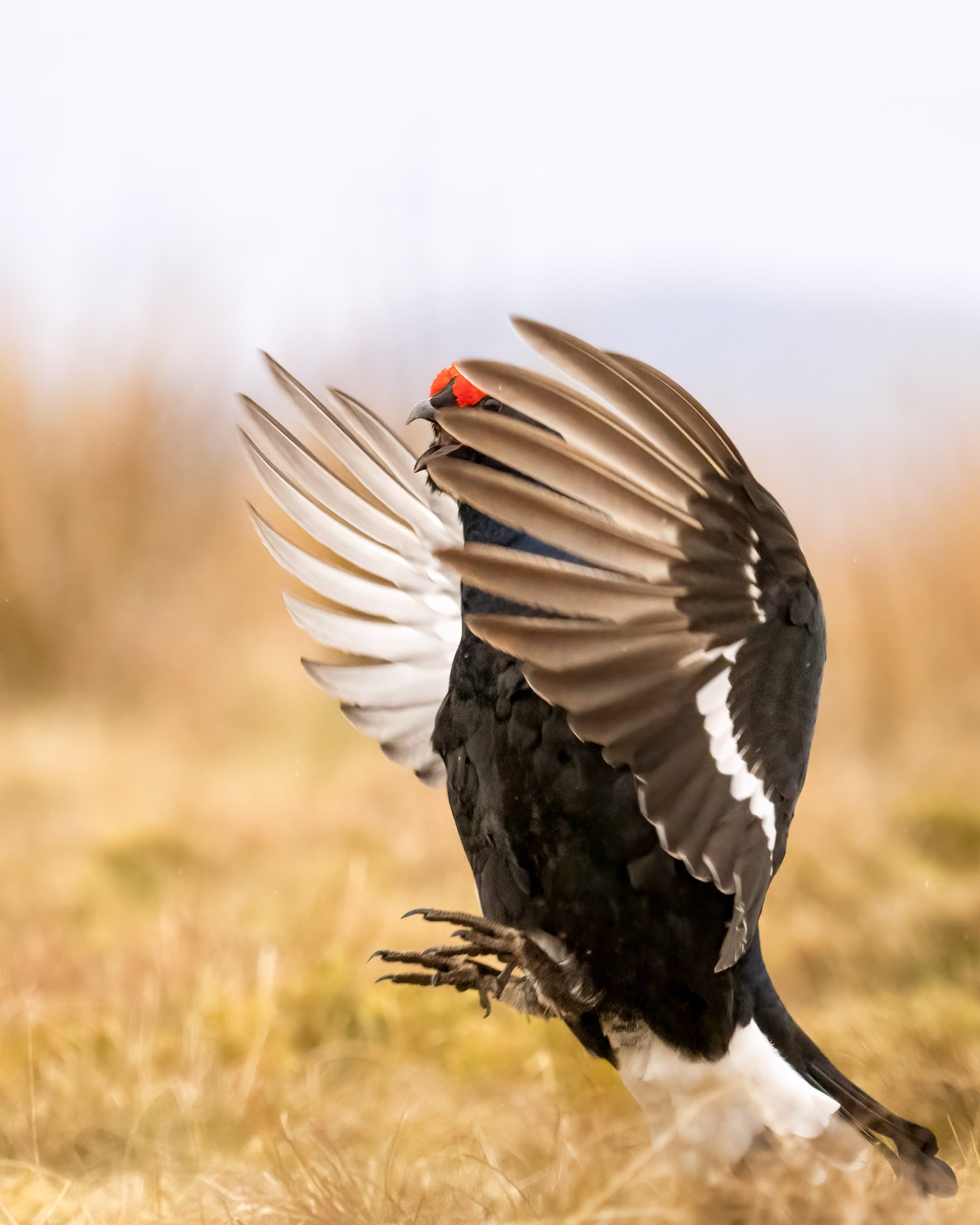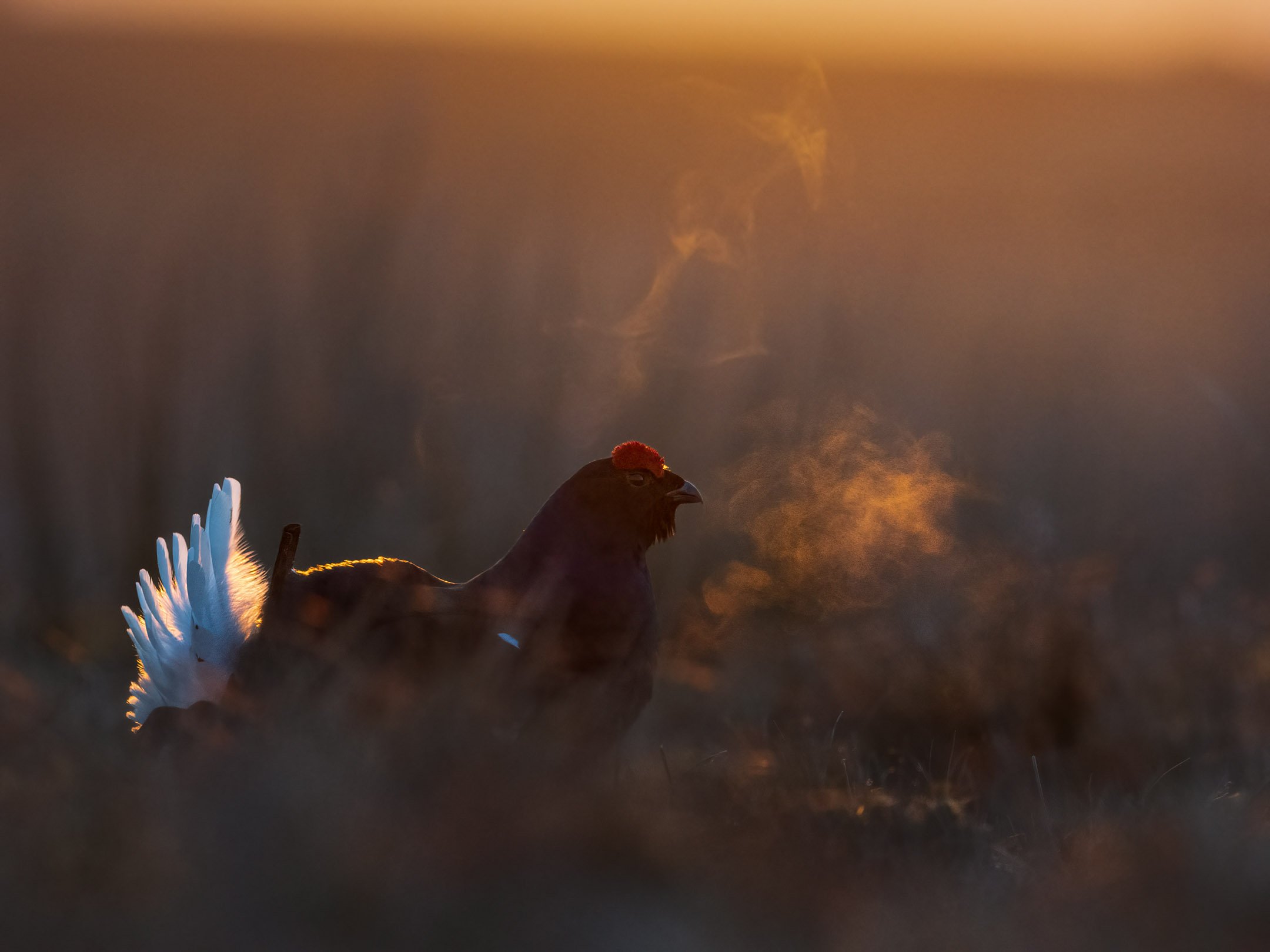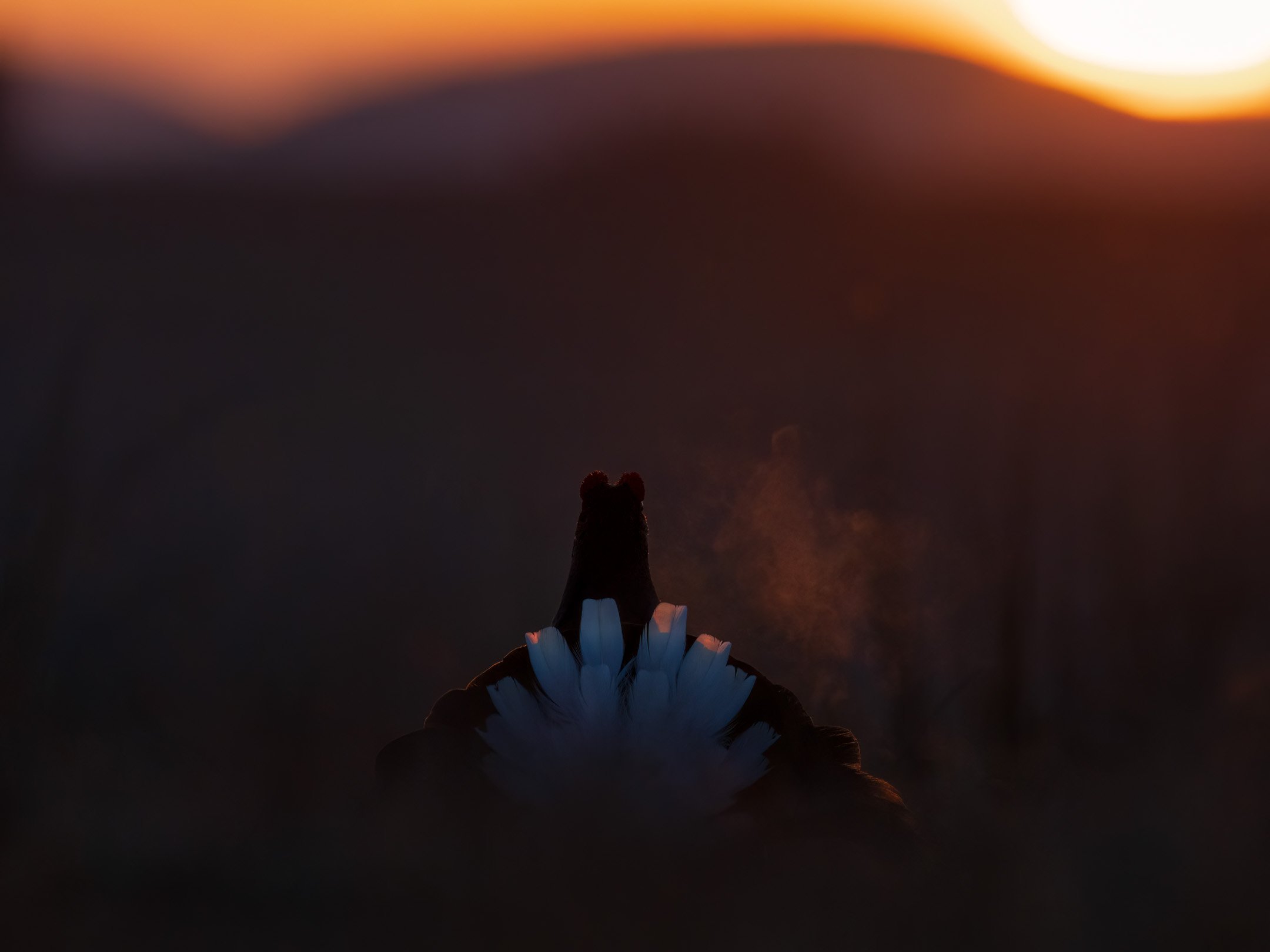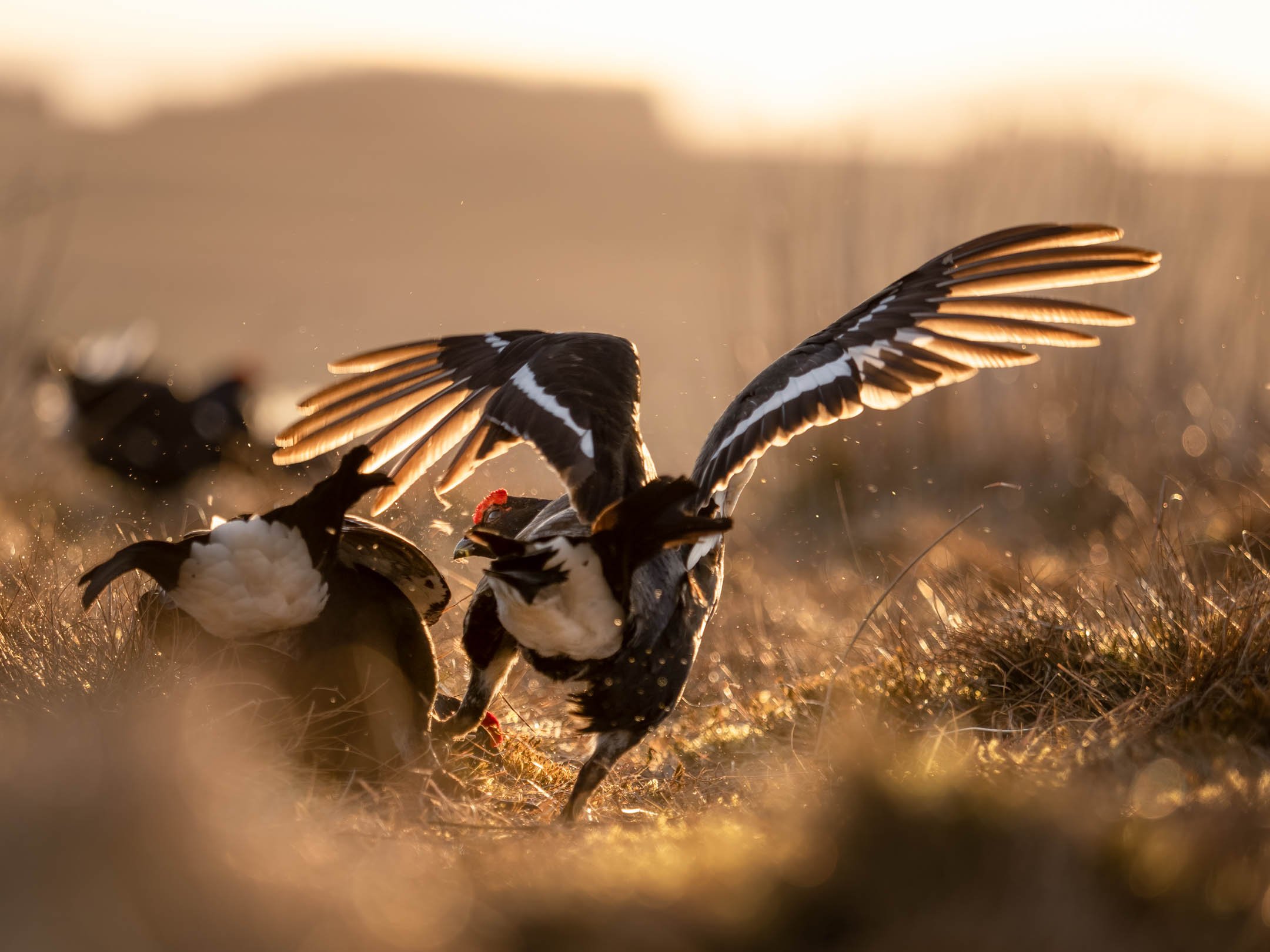Black Grouse Lek Photography
Black Grouse are stunning, secretive birds with a thrilling courtship display. Extremely sensitive to disturbance, it can be a challenge to photograph them, but with the right set up, it’s an unforgettable experience.
Scarface Backlit - EM1X, 300mm (600mm) f/4, 1/800s, ISO 200
WHY PHOTOGRAPH A BLACK GROUSE LEK
Black grouse leks are mesmerising, dramatic spectacles. The first time I encountered a black grouse lek, I couldn’t believe all the action going on around me. Hours before the sun came up, I sat in the dark, hoping I was in the right place. Before long, the unmistakable bubbly popping calls began, and I could hear the sound of flapping wings as the cocks arrived at the site. As the sun came up, it was an incredible experience to watch the strutting and the parading, all males vying for the female’s attention as they looked on. It’s not always comfortable to be in position for photography for the duration of a lek, but it’s always worth it for such a full sensory experience.
Black Grouse arriving on lek | OM-1, 300mm (600mm) f/4, 1/2500s, ISO 400
At the black grouse lek workshops that I’ve been running in Perthshire I use Tragopan hides to photograph the birds without disturbing them. We make sure we’re inside the hides about 1 hour and 20 min before sunrise so that we’re hidden before the first birds arrive on the lek.
The first birds tend to arrive over an hour before sunrise while it’s still way too dark for photography. So lie down and enjoy the sounds of the hills, I often hear snipe drumming and curlews and skylarks singing long before the sun rises.
I really like to start photographing during the blue hour, I find the light just before the sun has risen over the horizon to be magical. For this I tend to use a very slow shutter speed so I can keep my ISO as low as possible.
So you can get a sense of focal length I’ve added the equivalent length for full frame in brackets, e.g. my 300mm is equivalent to a 600mm full frame.
Black Grouse during the blue hour | OM-1, 300mm (600mm) f/4, 1/50s, ISO 5000
Black Grouse | OM-1, 300mm (600mm) f/4, 1/15s, ISO 200
If there’s any fighting early on I prefer to also photograph this with a slow shutter speed rather than send my ISO through the roof. Using a slow shutter speed for fast motion mostly ends up as nothing, but every now and then I end up with some blurriness I quite like.
This can also be a good time to try for a panning shot, turn off image stabilisation (or set it to vertical) and pan along with the bird as it moves or jump. The idea here is to blur the background and get the bird, or part of the bird relatively sharp.
Black Grouse Fighting | OM-1, 300mm (600mm) f/4, 1/13s, ISO 400
Panning with black grouse running | OM-1, 40-150mm f/2.8 + 1.4x, 210mm (420mm), f/4, 1/15s, ISO 1600
Want to join me on a workshop?
One behaviour to look out for is jumping, the black grouse regularly perform small jumps as they go about with their hissing calls. These are relatively easy to predict after you’ve watched them for a while.
If you do use the OM System you could try to use Pro Capture if you struggle to predict the jump.
Occasionally the whole lek comes alive and several grouse start with longer jumps or small flights. These can be a bit trickier to capture and I’ve relied on the quick AI AF bird detection on my OM-1 to get these images.
For both these kinds of jumps I recommend a shutter speed of at least 1/1600s to freeze the bird in motion, or at least get the eye of the bird sharp.
A larger jump | OM-1, 40-150mm f/2.8 + 1.4x, 200mm (400mm), f/4, 1/1600s, ISO 8000
A larger jump | OM-1, 40-150mm f/2.8 + 1.4x, 180mm (360mm), f/4, 1/1600s, ISO 10000
A small jump backlit | OM-1, 300mm (600mm) f/4, 1/4000, ISO 500
OM System for Wildlife Photography Course
Check out my course if you want to learn more about how I expose my images as well as my settings setup and approach to wildlife photography using the OM System.
Sometimes you’ll see the females in amongst the rushes or being chased by the males. I had a curious female come close to my hide to check it out once and luckily I had a zoom ready to get an image as she approached the hide.
An important side not here, I would not try to switch cameras as she approached. The closer the grouse get to the hide the less movement we can make and the more quiet we need to keep.
Another time to keep very quiet is if the entire lek suddenly stops and all the birds go silent. This usually happens if the grouse think there might be danger nearby, this could be a bird of prey passing above, or a fox nearby, or even anything that barely resembles a predator. It’s better to be safe than sorry when you’re life is at stake.
When this happens it’s important to lie still and not make a move until he grouse start back up again.
A curious female black grouse | OM-1, 40-150mm f/2.8, 60mm (120mm) f/2.8, 1/640s, ISO 4000
One of my favourite ways to photograph the black grouse or almost any subject for that matter is backlit. That means shooting into the sun or rather at a slight angle to it.
I find that there’s more room for creativity shooting backlit and I also find that distractions such as the surrounding grassland can be more easily ‘hidden’ in the final image.
Black grouse lek backlit | OM-1, 40-150mm f/2.8, 150mm (300mm), f/2.8, 1/1600s, ISO 640
If it’s a cold morning shooting backlit means we might also be able to capture the breath of the grouse as they call.
Black grouse breath backlit | OM-1, 300mm f/4 (600mm), 1/1600s, ISO 3200
Black grouse breath backlit | OM-1, 300mm f/4 (600mm), 1/2500s, ISO 1000
I often preach keeping your ISO as low as possible, but you can’t be afraid to push it higher whilst photographing the lek so that you’re certain to freeze the action. You don’t want to miss those split seconds when the grouse are fighting and you want to be sure that the birds are sharp, so push that ISO as high as you need to in order to get a shutter speed of at least 1/1600 or preferably higher.
I use DxO Pure Raw 3 to clean up noisy images and it does an amazing job! Sign up for a free 30 day trial and test it out for yourself.
Black grouse fighting backlit | EM1X, 40-150mm f/2.8, 150mm (300mm), f/2.8, 1/2000s, ISO 200
A black grouse lek truly is one of natures amazing spectacles so remember to just enjoy the experience :)
Female black grouse approached by a male during blue hour | OM-1, 40-150mm f/2.8, 150mm (300mm) f/2.8, 1/1000s, ISO 6400

















